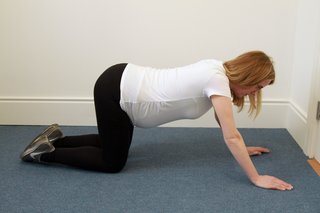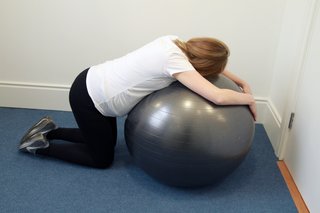Most women with pelvic girdle pain (PGP) can have a normal vaginal birth. Some birthing positions may be more comfortable than others. Moving around during labour can help.
Practise different birthing positions during your pregnancy. If you notice some are more comfortable than others, record them in your birth wishes or birth plan.
Many women with PGP find it uncomfortable to give birth on their backs. They can find standing, kneeling or being on all fours to be more comfortable. You may also find it more comfortable to lie on your side.
You might also prefer to lie on your side during internal (vaginal) examinations. If so, speak to your midwife or obstetrician.
First stage of labour
This is the period of time from when labour begins until your cervix is fully dilated.
Standing, walking or sitting keeps you upright. This uses gravity to encourage your baby’s head to engage into the pelvis. It is helpful to have an active labour for as long as you can.
If walking is too painful, you can keep yourself upright in other ways. You could try sitting on a gym or birthing ball or use the comfortable upright birth (CUB). CUB is a horseshoe-shaped support. It is more stable than a ball. You could also sit on a chair or lean forward while resting on a bed.
You can keep your pelvis moving by walking, rocking on a gym or birthing ball or swaying your hips standing.
If you are experiencing a lot of lower back pain or tailbone pain, try kneeling on all fours. This can take your baby’s weight away from your back. It may also help if you have severe pubic pain and find keeping your legs apart uncomfortable.


You may find it comfortable to use a peanut ball to support you in certain positions during labour. This is a double birth ball, connected in the middle and shaped like a peanut. This can also help progress labour if you have an epidural.

Second stage of labour
This is the period of time from when your cervix is fully dilated until your baby is born.
Kneeling on all fours or in a forward lean position can be comfortable for birth. The back of the bed can be positioned upright to allow you to lean against it.
You might also find lying on your side comfortable. Support your least painful leg with pillows, a foot rest or peanut ball. This is particularly useful if you have had an epidural.
You can also use the peanut ball in side-lying to support your leg.
After the birth
After the birth, move around as much as possible. Ask if a bed close to the toilet is available to reduce the distances you have to walk.
You may need extra support to help you care for your baby. Ask your partner or support person to stay and help you. Someone may need to lift the baby to you for feeding and nappy changing.
Be aware of your posture when you are feeding your baby. Make sure your back is well supported.
Future pregnancies
You may experience PGP again in your next pregnancy. It could be similar to this pregnancy or may be less severe.
Between pregnancies, practise any exercises that your physiotherapist gives you. Deep abdominal strengthening exercises and pelvic floor exercises are particularly important.
Early in your next pregnancy, ask your GP, midwife or obstetrician to refer you to a chartered physiotherapist.
When planning your next pregnancy, it might be worth considering how old your baby will be. Some women with PGP delay their next pregnancy until their current baby or toddler can walk.
